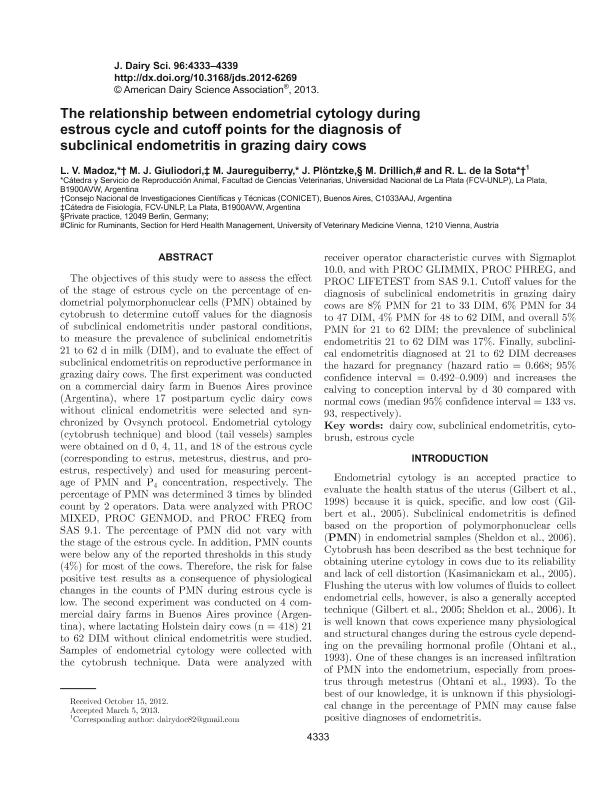Mostrar el registro sencillo del ítem
dc.contributor.author
Madoz, Laura Vanina

dc.contributor.author
Giuliodori, Mauricio Javier

dc.contributor.author
Jaureguiberry, María

dc.contributor.author
Plöntzke, J.
dc.contributor.author
Drillich, M.
dc.contributor.author
de la Sota, Rodolfo Luzbel

dc.date.available
2017-08-28T15:28:47Z
dc.date.issued
2013-05
dc.identifier.citation
Madoz, Laura Vanina; Giuliodori, Mauricio Javier; Jaureguiberry, María; Plöntzke, J.; Drillich, M.; et al.; The relationship between endometrial cytology during estrous cycle and cutoff points for the diagnosis of subclinical endometritis in grazing dairy cows; Elsevier; Journal of Dairy Science; 96; 7; 5-2013; 4333-4339
dc.identifier.issn
0022-0302
dc.identifier.uri
http://hdl.handle.net/11336/23101
dc.description.abstract
The objectives of this study were to assess the effect of the stage of estrous cycle on the percentage of endometrial polymorphonuclear cells (PMN) obtained by cytobrush to determine cutoff values for the diagnosis of subclinical endometritis under pastoral conditions, to measure the prevalence of subclinical endometritis 21 to 62 d in milk (DIM), and to evaluate the effect of subclinical endometritis on reproductive performance in grazing dairy cows. The first experiment was conducted on a commercial dairy farm in Buenos Aires province (Argentina), where 17 postpartum cyclic dairy cows without clinical endometritis were selected and synchronized by Ovsynch protocol. Endometrial cytology (cytobrush technique) and blood (tail vessels) samples were obtained on d 0, 4, 11, and 18 of the estrous cycle (corresponding to estrus, metestrus, diestrus, and proestrus, respectively) and used for measuring percentage of PMN and P4 concentration, respectively. The percentage of PMN was determined 3 times by blinded count by 2 operators. Data were analyzed with PROC MIXED, PROC GENMOD, and PROC FREQ from SAS 9.1. The percentage of PMN did not vary with the stage of the estrous cycle. In addition, PMN counts were below any of the reported thresholds in this study (4%) for most of the cows. Therefore, the risk for false positive test results as a consequence of physiological changes in the counts of PMN during estrous cycle is low. The second experiment was conducted on 4 commercial dairy farms in Buenos Aires province (Argentina), where lactating Holstein dairy cows (n = 418) 21 to 62 DIM without clinical endometritis were studied. Samples of endometrial cytology were collected with the cytobrush technique. Data were analyzed with receiver operator characteristic curves with Sigmaplot 10.0, and with PROC GLIMMIX, PROC PHREG, and PROC LIFETEST from SAS 9.1. Cutoff values for the diagnosis of subclinical endometritis in grazing dairy cows are 8% PMN for 21 to 33 DIM, 6% PMN for 34 to 47 DIM, 4% PMN for 48 to 62 DIM, and overall 5% PMN for 21 to 62 DIM; the prevalence of subclinical endometritis 21 to 62 DIM was 17%. Finally, subclinical endometritis diagnosed at 21 to 62 DIM decreases the hazard for pregnancy (hazard ratio = 0.668; 95% confidence interval = 0.492–0.909) and increases the calving to conception interval by d 30 compared with normal cows (median 95% confidence interval = 133 vs. 93, respectively).
dc.format
application/pdf
dc.language.iso
eng
dc.publisher
Elsevier

dc.rights
info:eu-repo/semantics/openAccess
dc.rights.uri
https://creativecommons.org/licenses/by-nc-sa/2.5/ar/
dc.subject
Dairy Cow
dc.subject
Subclinical Endometritis
dc.subject
Cytobrush
dc.subject
Estrous Cycle
dc.subject.classification
Otras Producción Animal y Lechería

dc.subject.classification
Producción Animal y Lechería

dc.subject.classification
CIENCIAS AGRÍCOLAS

dc.title
The relationship between endometrial cytology during estrous cycle and cutoff points for the diagnosis of subclinical endometritis in grazing dairy cows
dc.type
info:eu-repo/semantics/article
dc.type
info:ar-repo/semantics/artículo
dc.type
info:eu-repo/semantics/publishedVersion
dc.date.updated
2017-08-23T20:37:03Z
dc.journal.volume
96
dc.journal.number
7
dc.journal.pagination
4333-4339
dc.journal.pais
Países Bajos

dc.journal.ciudad
Ámsterdam
dc.description.fil
Fil: Madoz, Laura Vanina. Consejo Nacional de Investigaciones Científicas y Técnicas; Argentina. Universidad Nacional de la Plata. Facultad de Ciencias Veterinarias. Departamento de Clínica. Cátedra de Reproducción Animal; Argentina
dc.description.fil
Fil: Giuliodori, Mauricio Javier. Consejo Nacional de Investigaciones Científicas y Técnicas; Argentina. Universidad Nacional de la Plata. Facultad de Ciencias Veterinarias. Departamento de Ciencias Básicas. Cátedra de Fisiología; Argentina
dc.description.fil
Fil: Jaureguiberry, María. Universidad Nacional de la Plata. Facultad de Ciencias Veterinarias. Departamento de Clínica. Cátedra de Reproducción Animal; Argentina. Consejo Nacional de Investigaciones Científicas y Técnicas; Argentina
dc.description.fil
Fil: Plöntzke, J.. Private practice; Alemania
dc.description.fil
Fil: Drillich, M.. University of Veterinary Medicine; Austria
dc.description.fil
Fil: de la Sota, Rodolfo Luzbel. Consejo Nacional de Investigaciones Científicas y Técnicas; Argentina. Universidad Nacional de la Plata. Facultad de Ciencias Veterinarias. Departamento de Clínica. Cátedra de Reproducción Animal; Argentina
dc.journal.title
Journal of Dairy Science

dc.relation.alternativeid
info:eu-repo/semantics/altIdentifier/url/http://www.sciencedirect.com/science/article/pii/S0022030213003573
dc.relation.alternativeid
info:eu-repo/semantics/altIdentifier/doi/http://dx.doi.org/10.3168/jds.2012-6269
Archivos asociados
